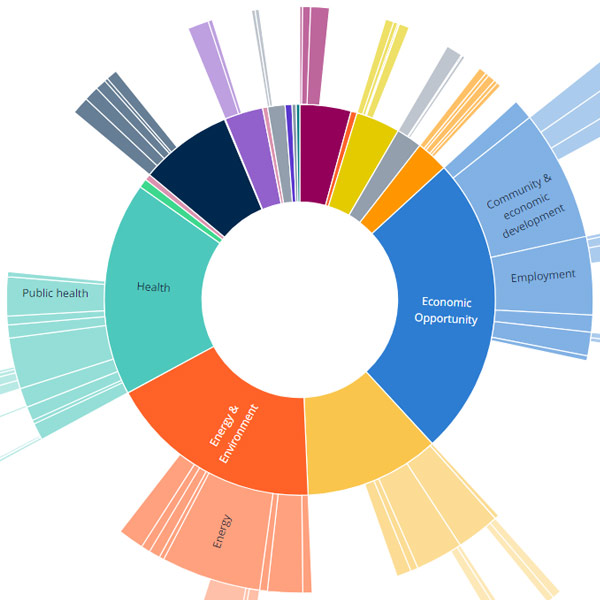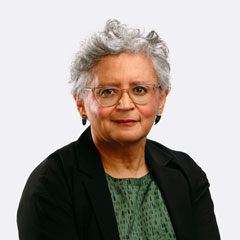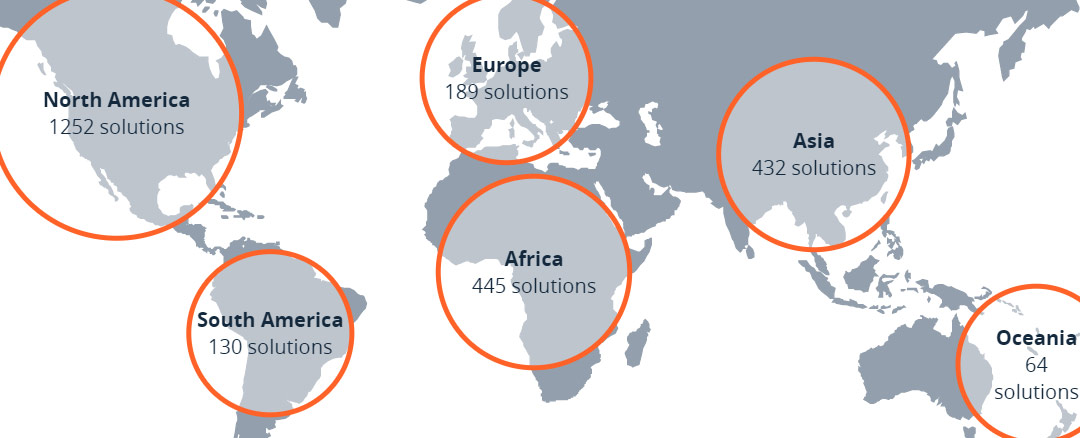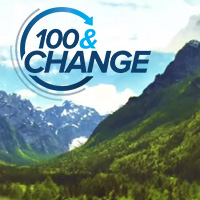Managing Director Cecilia Conrad offers several use cases for the 100&Change Solutions Bank, a searchable database of submissions to the 100&Change competition that has become a one-of-a-kind resource for funders, researchers, and the nonprofit sector.
Our original goal for 100&Change, an open competition for a single $100 million grant, was fairly simple: identify a project outside our usual networks that with substantial resources disbursed over a compressed time period (three to five years) could make significant progress in addressing a critical problem. And we succeeded. In December 2017, MacArthur's board of directors selected an early childhood intervention project, a collaboration between Sesame Workshop and the International Rescue Committee, as the recipient of the $100 million grant. The other three finalists — Catholic Relief Services, HarvestPlus, and the Rice 360° Institute for Global Health (Rice University) — were each awarded grants of $15 million and a commitment from MacArthur to help identify additional sources of funding.
After we launched the competition, however, we realized that 100&Change's open call had an important side benefit: the surfacing of a wealth of ideas for solving problems around the globe, ideas at various stages of development but good ideas nonetheless. We were logging those ideas into a database here at the foundation, but we soon recognized the database could be a public resource serving other funders who might find interesting projects to support, communities looking for innovative solutions to their challenges, and problem-solvers and researchers looking for others with similar interests. So, after a number of conversations and phone calls, we found ourselves collaborating with Foundation Center on the 100&Change Solutions Bank, a searchable (by geography, subject area, keyword, and Sustainable Development Goal) repository of submissions to the 100&Change competition.
Interesting, right? But maybe you're not sure how the Solutions Bank can help you. No problem. Here are four sample use cases:
- A family foundation wants to identify projects that can help advance a particular Sustainable Development Goal (SDG). Foundation Center has matched all proposals in the Solutions Bank to an SDG focus and has created a really nice dashboard that includes a visual summary of that data. For example, the most frequent SDG focus represented among the 100&Change project proposals is SDG 3, "Good Health and Well-Being," with 543 submissions; the least frequent is SDG 15, "Life Below Water," which attracted only 11 submissions.
- A community foundation is looking for project ideas that address the needs of the community's aging population. Under the Populations tab on the Solutions Bank dashboard, the foundation will find 37 proposals with senior citizens listed as a target population. (I was surprised so few of the 1,872 proposals in the Solutions Bank focused on seniors; by contrast, 386 targeted children and youth.)
- Memphis-based People First Partnership, an early childhood education program that submitted a proposal to 100&Change, wants to know if there are funders that have supported projects similar to theirs. Because the Solutions Bank provides information about past funders of organizations that submitted proposals, People First can go to its Solutions Bank page and find the Hunts Point Alliance for Children in the box titled "More Like This." And by clicking through to the Hunts Point Alliance's page, it can find a list of past funders of that Bronx-based organization.
- Because Foundation Center classified proposals by strategy, a foundation with a specific strategy focus (e.g., capital and infrastructure) could use the Solutions Bank to identify 105 projects aligned with the same focus.
Hunts Point Alliance for Children
The Solutions Bank can also be a launch point for other kinds of analyses. For example, I recently gave a talk to the National Economic Association, an organization focused on promoting the professional lives of minority economists, and I knew beforehand the audience would be interested in projects that address racial inequality. So, I went to the Solutions Bank and used a combination of keyword searches and built-in filters to identify sixty-two projects focused on racial inequality in the United States. (That is a somewhat subjective count, given it includes projects self-identified as focused on equity and inclusion as well as projects that used "racial inequality" or "racial equity" in the text of their proposals.)
Next, I read each proposal and applied a taxonomy based on three explanations for the persistence of racial disparities frequently cited in economics literature: (a) gaps in human and social capital; (b) market failure; and (c) discrimination and structural/institutional racism.
- Gaps in Human and Social Capital – twenty-six projects proposed remediating gaps in human and social capital through education and employment training, coaching and mentoring programs, health and behavioral interventions, leadership development initiatives, and organizational capacity building.
- Market failure – eight proposals addressed various types of market failure through place-based economic stimulus activities, black business development, and workforce development.
- Discrimination and Structural/Institutional Racism – nineteen proposals address discrimination and racism. Nine focused on improving race relations through storytelling, social interaction and dialogue, while an additional ten address racism at a more systemic level through things like community organizing, education systems change, reparations, and policy/legal reform.
- All of the above – four proposals take a holistic approach that would fit all three categories.
Using the Solutions Bank for an analysis of this type is labor intensive, but the intelligence I was able to gather was well worth the time invested.

Explore subjects in this interactive diagram ›
The Solutions Bank has limitations. An important one is that it represents a snapshot of the sector at a single moment in time (October 2016). At present, we have no means to update the information as projects evolve. For example, we know from e-mail communications and its website that the Manufacturing Renaissance project, which links manufacturing jobs with education infrastructure to spur community development, has made significant progress over the past year. For our next iteration of 100&Change, we want to think about how to make the database more dynamic. Even with these and other limitations, the Solutions Bank is a one-of-a-kind resource for funders, researchers, and the nonprofit sector. But don't take our word for it – take it for a test drive yourself.
This piece originally ran in PhilanTopic, a Philanthropy News Digest blog.





